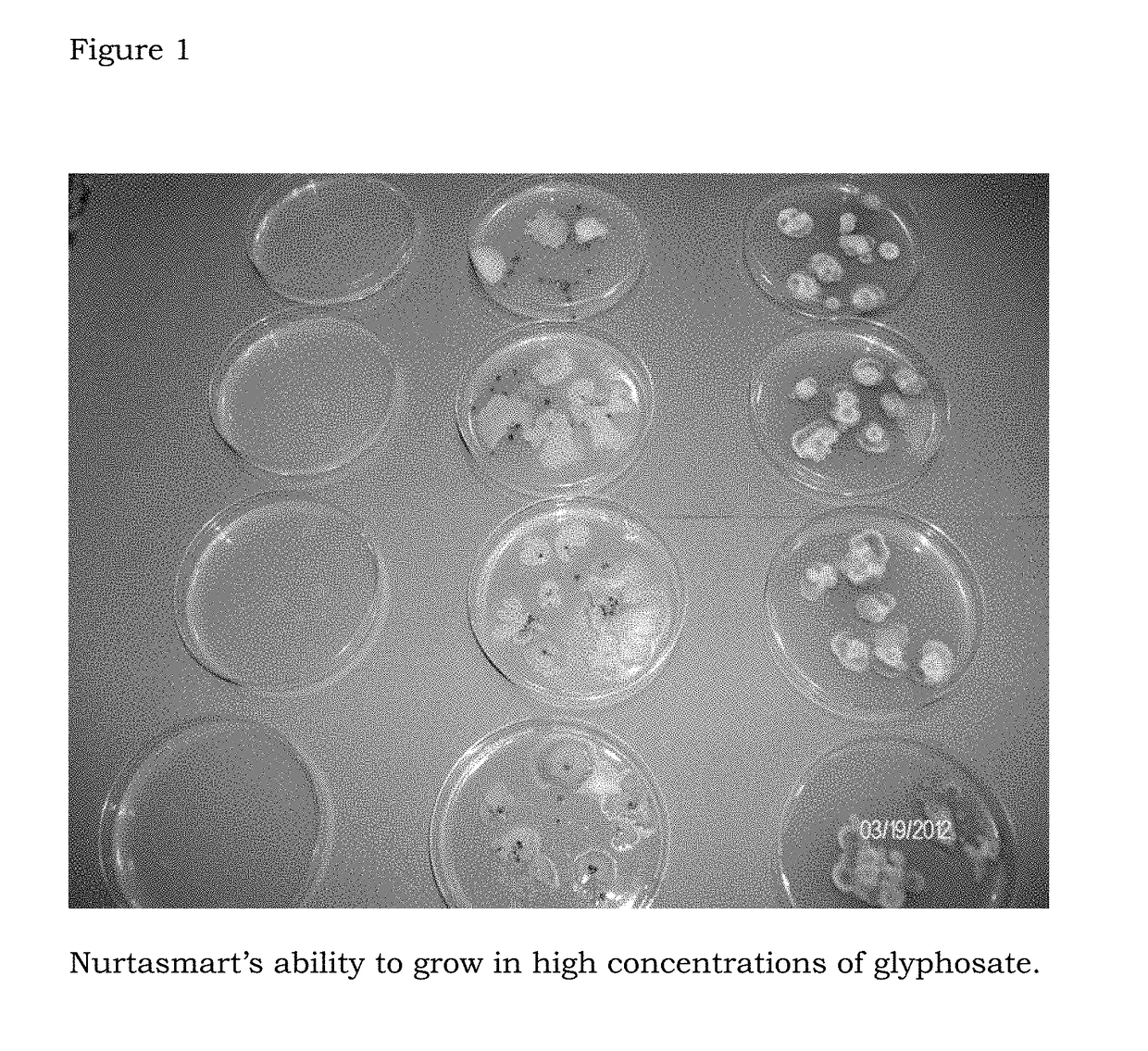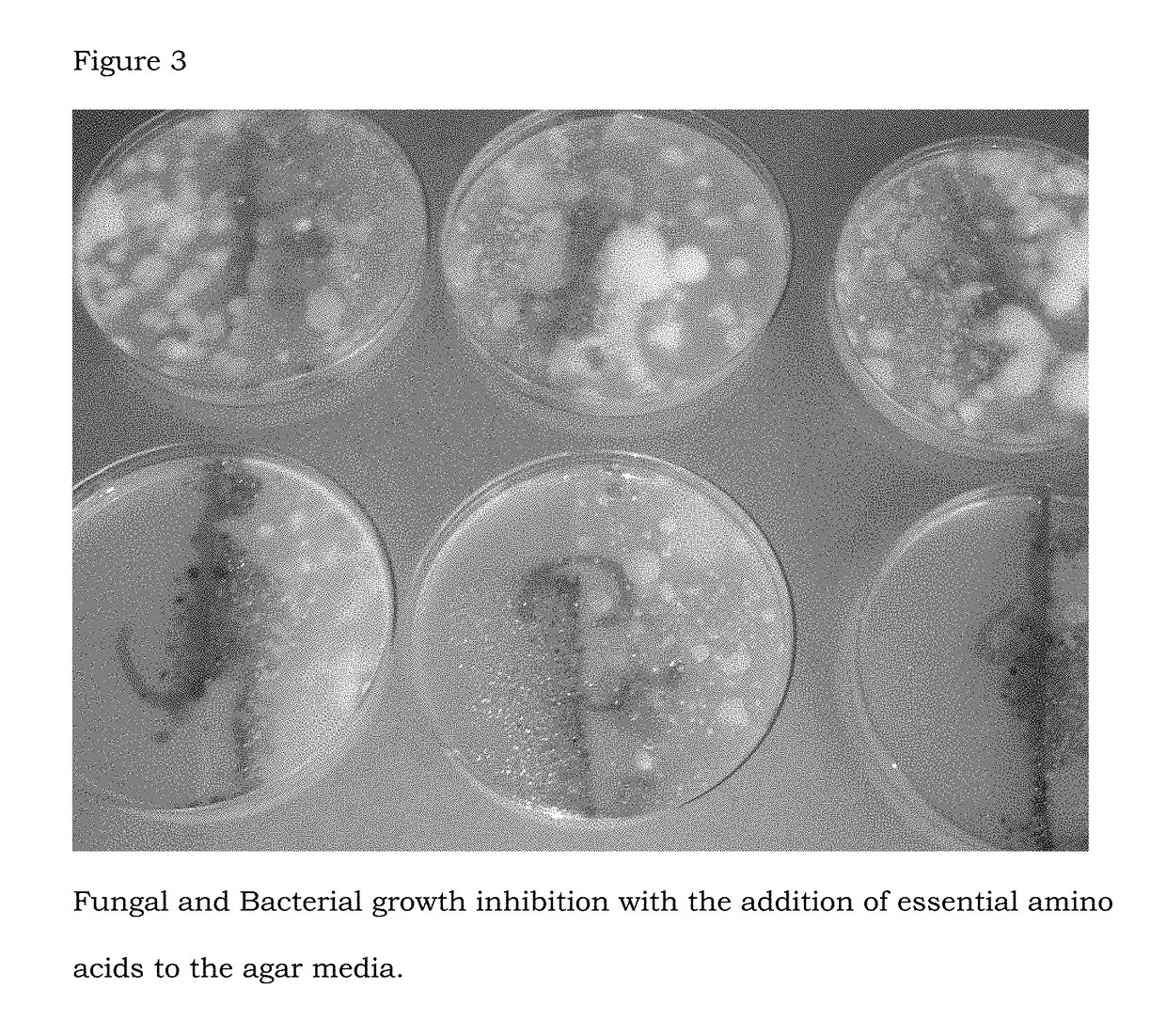Method for amelioration of the glyphosate effect
a technology of glyphosate and glyphosate, applied in the field of glyphosate melioration, can solve the problems of reducing the growth and vigor of plants, threatening their sustainability, and immobilizing micronutrients, so as to prevent the herbicidal effect of glyphosate, increase the disease pressure on plants, and reduce crop yield
- Summary
- Abstract
- Description
- Claims
- Application Information
AI Technical Summary
Benefits of technology
Problems solved by technology
Method used
Image
Examples
example 1
[0024]Growers typically spray 1 quart of a 39% glyphosate solution per acre, at a dilution of one quart in 20 gallons of water. That would be a dilution of 80 to 1, or 1.25%. Because I purchased a 25% glyphosate I had to make a concentration adjustment.
0.39 / 0.25=1.56 concentration difference.
[0025]So, 1.25*1.56=or 1.95% of the 25% glyphosate is the equivalent. In 300 ml mix of Difco Plate Count Agar, I added 6 ml of the 25% Glyphosate. As the agar cooled I dropped NutriSmart® additive into the media. Control on the left, SGN 150 center and SGN 250 on the right. (FIG. 1).
[0026]This experiment shows the ability of the NutriSmart® additive to catabolize the glyphosate pesticide. It appears the addition of glyphosate to the media selects out fungal populations commonly found in soil.
example 2
[0027]An increase of 100× in overall bacterial activity after 7 days in soils seeded with NutriSmart® additive—both in glyphosate treated soil (4% solution) and soil with no added glyphosate. As seen in FIG. 2, the effect is slightly greater in the glyphosate added soil. The fungal presence appears fairly constant in both treatments.
[0028]This experiment shows the ability of the NutriSmart® additive to catabolize the glyphosate pesticide in soil while promoting bacterial growth inhibited by the glyphosate acting as a biocide. It appears the addition of glyphosate to the media selects out fungal populations commonly found in soil; while NutriSmart® additive promotes both fungal and bacterial growth. NutriSmart® additive reportedly is composed of Saccharomyces cerevisiae at 106 cfu / g, starch, Leonardite / lignite, and, naturally-occurring substances found in the yeast fermentation broth. NutriSmart® additive supports and increases nitrogenase levels in the soil.
example 3
[0029]Tomato plants growing in glyphosate treated soil from Ohio had symptoms of disease. The sap from the stems of these plants was placed in Difco Plate Count Agar and bacteria and fungi prospered. However, the addition of essential amino acids at ppm concentrations was enough to inhibit the growth with strong lines of inhibition (FIG. 3). When the amino acids were replaced with a chelated metal solution the same line of inhibition was found. The amino acids added were Phenylalanine, Tyrosine, and Indole (a precursor to Tryptophan). The chelated metal solution consisted of 1% chelated nickel, 1.69% molybdic oxide and 0.24% selenium oxide.
[0030]This experimental breakthrough shows the pathogens present in the tomato plants could have been easily controlled by the plant itself if essential amino acid production had not been curtailed by prior use of pesticides that block plant essential amino acid biochemical pathway.
PUM
 Login to View More
Login to View More Abstract
Description
Claims
Application Information
 Login to View More
Login to View More - R&D
- Intellectual Property
- Life Sciences
- Materials
- Tech Scout
- Unparalleled Data Quality
- Higher Quality Content
- 60% Fewer Hallucinations
Browse by: Latest US Patents, China's latest patents, Technical Efficacy Thesaurus, Application Domain, Technology Topic, Popular Technical Reports.
© 2025 PatSnap. All rights reserved.Legal|Privacy policy|Modern Slavery Act Transparency Statement|Sitemap|About US| Contact US: help@patsnap.com



